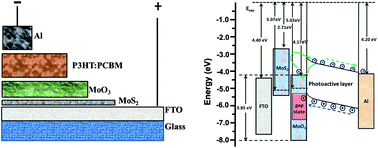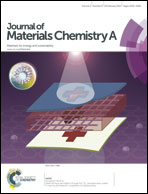In situ growth of double-layer MoO3/MoS2 film from MoS2 for hole-transport layers in organic solar cell
Abstract
Efficient organic solar cells (OSCs) based on regioregular poly(3-hexylthiophene):fullerene derivative [6,6]-phenyl-C61butyric acid methyl ester composites have been fabricated on fluorine-doped tin oxide (FTO) coated glass substrates by a radio frequency (RF) sputtered and ultraviolet ozone (UVO) treated MoS2 film as the hole-transport layer (HTL). With the help of X-ray photoelectron spectroscopy, ultraviolet photoelectron spectroscopy, Raman spectroscopy, transmission spectra and the Hall-effect system, we find that the deposition temperature can modulate the contents of the various valence states of molybdenum, which can result in changes of the energy level, and the optical and electrical properties of the MoS2 films. MoS2 has been oxidized to a double-layered MoO3–MoS2 film by UVO treatment. Due to the presence of the molybdenum oxidation states Mo5+ and Mo6+, the MoS2 film shows p-type conductive behavior, and its smaller electron affinity can effectively block electron from exciton dissociation. By optimizing the HTL thickness and sputtering deposition temperature, a power conversion efficiency up to 4.15% has been achieved for an OSC that used a double-layered MoO3–MoS2 film as the HTL. Its JSC is bigger than that of the OSC with a pure MoO3 film as the HTL. This shows that this double layer MoO3–MoS2 interface is more favorable for hole-transfer.


 Please wait while we load your content...
Please wait while we load your content...